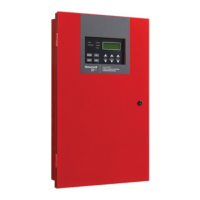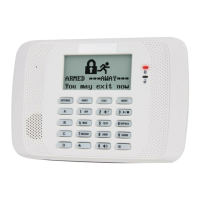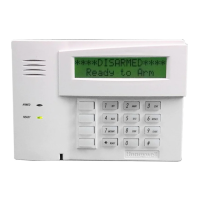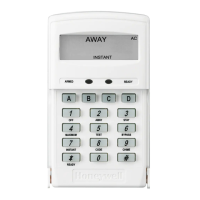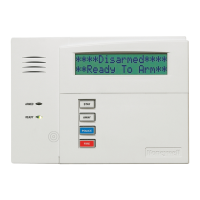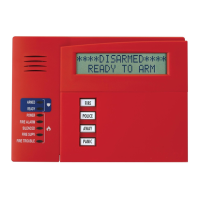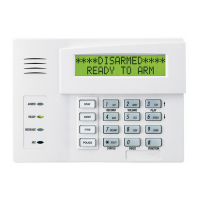Do you have a question about the Honeywell 6820EVS and is the answer not in the manual?
Describes the fundamental structure and capabilities of the 6820/6820EVS base system.
Lists available Honeywell Silent Knight products compatible with the 6820 and 6820EVS.
Provides FCC information required for connecting the 6820/6820EVS to telephone lines.
Details UL requirements for various installation types and restricted options for certified installations.
Lists the components expected in the 6820/6820EVS shipment for verification.
Outlines environmental precautions and conditions for proper control panel operation.
Recommends downloading the most current software version for latest features and functionality.
Outlines the steps for determining current draw and standby battery needs for system devices.
Provides a table to determine current requirements for SK SLC devices during alarm/standby.
Provides instructions for surface and flush mounting of the 6820 and 6820EVS cabinets.
Details the procedure for connecting the panel to the AC power source, emphasizing safety.
Explains battery requirements, connection, and the use of accessory cabinets for backup power.
Contains information on calculating SBUS wire distances and wiring configurations (Class A and B).
Provides instructions for installing the optional 5860 Remote Annunciator.
Details the installation process for the 5815XL SLC expander.
Describes how to install conventional notification appliances for Class A and Class B configurations.
Covers connecting the panel to remote station receivers and city box connections.
Describes the networking capabilities and limitations of the 6820/EVS panels.
Details the methods for connecting panels using fiber optic or twisted pair wiring.
Covers tools for checking network performance like Ping Panel and Data Network Status.
Explains how to program network options using the built-in annunciator or software.
Lists compatible SK SLC devices, including detectors and modules with part numbers.
Lists compatible SD SLC devices, including detectors and modules with part numbers.
Provides information on wire sizing and maximum distances for SLC devices.
Explains the automated system setup feature that configures SLC and SBUS devices.
Provides a high-level overview of mapping events to outputs and configuring zones and output groups.
Details how to map various system, zone, panel, and site events to output groups and patterns.
Lists programming options that must be limited or not used to comply with UL standards.
Details how to edit, add, delete, and view system modules like annunciators and expanders.
Explains how to edit zone names, properties, and accessory options.
Covers programming individual input and output points, including device type and mapping.
Covers customization of software options like communication, time, and daylight savings settings.
Describes the annunciator layout, including LEDs and keys for system interaction.
Provides an overview of the control panel's menu structure and navigation.
Explains fundamental operations like setting time/date, enabling/disabling points, and conducting tests.
Describes how the control panel manages and prioritizes events from fire and emergency systems.
Details the control panel's support for single and double interlock zone releasing operations.
Details the functionality of Local Operator Consoles (LOCs), including keys, LEDs, and EVS control.
Explains the conditions and procedures for gaining EVS control at an LOC.
Explains how to manually activate EVS events, page, and switch between modes.
Covers adding and editing amplifiers for the EVS system.
Details how to add and edit Local Operator Consoles (LOCs) and their priority.
Lists compatible receivers and their supported formats (SIA, Contact ID).
Provides detailed tables of event descriptions and their corresponding SIA and Contact ID reporting codes.
Lists common issues encountered during installation and operation with suggested solutions.
Recommends scheduled system inspection and testing by qualified personnel.
Describes diagnostic tools like SLC Device Locator and I/O Point Control for system testing.
Provides tables to record detector and module points installed on SLC loops.
Lists compatible notification appliances, including audio and visual devices, and sync capabilities.
Lists compatible two-wire smoke detectors and their specifications.
Lists compatible four-wire smoke detectors and their current ratings.
Lists compatible door holders and their current specifications.
Lists compatible relays and their current specifications.
Lists programmable characters and their numeric designators for text entry.
Provides a step-by-step example of editing names using the built-in programmer.
Correlates panel numbers with available receiver numbers for system configuration.
Provides a checklist for cyber security tasks and data protection during installation and maintenance.
Describes the fundamental structure and capabilities of the 6820/6820EVS base system.
Lists available Honeywell Silent Knight products compatible with the 6820 and 6820EVS.
Provides FCC information required for connecting the 6820/6820EVS to telephone lines.
Details UL requirements for various installation types and restricted options for certified installations.
Lists the components expected in the 6820/6820EVS shipment for verification.
Outlines environmental precautions and conditions for proper control panel operation.
Recommends downloading the most current software version for latest features and functionality.
Outlines the steps for determining current draw and standby battery needs for system devices.
Provides a table to determine current requirements for SK SLC devices during alarm/standby.
Provides instructions for surface and flush mounting of the 6820 and 6820EVS cabinets.
Details the procedure for connecting the panel to the AC power source, emphasizing safety.
Explains battery requirements, connection, and the use of accessory cabinets for backup power.
Contains information on calculating SBUS wire distances and wiring configurations (Class A and B).
Provides instructions for installing the optional 5860 Remote Annunciator.
Details the installation process for the 5815XL SLC expander.
Describes how to install conventional notification appliances for Class A and Class B configurations.
Covers connecting the panel to remote station receivers and city box connections.
Describes the networking capabilities and limitations of the 6820/EVS panels.
Details the methods for connecting panels using fiber optic or twisted pair wiring.
Covers tools for checking network performance like Ping Panel and Data Network Status.
Explains how to program network options using the built-in annunciator or software.
Lists compatible SK SLC devices, including detectors and modules with part numbers.
Lists compatible SD SLC devices, including detectors and modules with part numbers.
Provides information on wire sizing and maximum distances for SLC devices.
Explains the automated system setup feature that configures SLC and SBUS devices.
Provides a high-level overview of mapping events to outputs and configuring zones and output groups.
Details how to map various system, zone, panel, and site events to output groups and patterns.
Lists programming options that must be limited or not used to comply with UL standards.
Details how to edit, add, delete, and view system modules like annunciators and expanders.
Explains how to edit zone names, properties, and accessory options.
Covers programming individual input and output points, including device type and mapping.
Covers customization of software options like communication, time, and daylight savings settings.
Describes the annunciator layout, including LEDs and keys for system interaction.
Provides an overview of the control panel's menu structure and navigation.
Explains fundamental operations like setting time/date, enabling/disabling points, and conducting tests.
Describes how the control panel manages and prioritizes events from fire and emergency systems.
Details the control panel's support for single and double interlock zone releasing operations.
Details the functionality of Local Operator Consoles (LOCs), including keys, LEDs, and EVS control.
Explains the conditions and procedures for gaining EVS control at an LOC.
Explains how to manually activate EVS events, page, and switch between modes.
Covers adding and editing amplifiers for the EVS system.
Details how to add and edit Local Operator Consoles (LOCs) and their priority.
Lists compatible receivers and their supported formats (SIA, Contact ID).
Provides detailed tables of event descriptions and their corresponding SIA and Contact ID reporting codes.
Lists common issues encountered during installation and operation with suggested solutions.
Recommends scheduled system inspection and testing by qualified personnel.
Describes diagnostic tools like SLC Device Locator and I/O Point Control for system testing.
Provides tables to record detector and module points installed on SLC loops.
Lists compatible notification appliances, including audio and visual devices, and sync capabilities.
Lists compatible two-wire smoke detectors and their specifications.
Lists compatible four-wire smoke detectors and their current ratings.
Lists compatible door holders and their current specifications.
Lists compatible relays and their current specifications.
Lists programmable characters and their numeric designators for text entry.
Provides a step-by-step example of editing names using the built-in programmer.
Correlates panel numbers with available receiver numbers for system configuration.
Provides a checklist for cyber security tasks and data protection during installation and maintenance.
| Connection | Wired |
|---|---|
| Backlight | Yes |
| Type | Keypad |
| Compatibility | Vista Series Control Panels |
| Power | 12 VDC |
| Operating Temperature | 0°C to 49°C (32°F to 120°F) |
| Humidity | 5% to 85% (non-condensing) |
